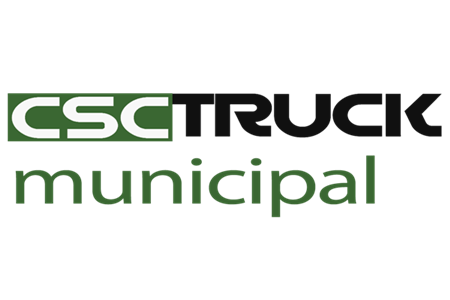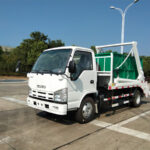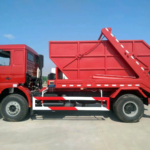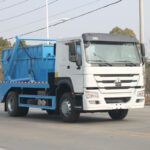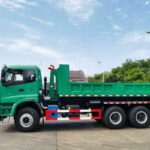In the evolving landscape of waste management, efficiency and adaptability are paramount for handling diverse waste streams across urban and industrial environments. Hook loader garbage trucks have emerged as a versatile solution, offering rapid container swapping capabilities that outperform traditional rear loaders and compactors in certain applications. These specialized vehicles utilize a hydraulic hook arm system to lift and transport detachable waste containers, providing unmatched flexibility for municipalities, recycling centers, and construction sites. This article examines the key design variations of hook loader systems, evaluates their performance across different operational scenarios, and compares their advantages to alternative waste collection methods like skip loader garbage trucks and compactor garbage trucks.
1. Understanding Hook Loader Mechanism and Core Components
The fundamental advantage of hook loader garbage trucks lies in their interchangeable container system, which allows a single truck to service multiple waste types without returning to a disposal site.
Critical Design Elements
- Hydraulic Hook Arm: A heavy-duty, computer-controlled lifting mechanism capable of handling containers weighing up to 20 tons, with precision alignment sensors to prevent misloading.
- Roll-On/Roll-Off (RO/RO) Chassis: Engineered with reinforced steel frames and sliding rails to accommodate containers ranging from 10 to 40 cubic yards.
- Multi-Stage Telescopic Cylinders: Provide extended reach for loading containers positioned at awkward angles or in confined spaces.
Performance Benchmarks
- Container Swap Time: Advanced models complete exchanges in under 3 minutes, compared to 15+ minutes for manual skip loading.
- Payload Optimization: Self-leveling suspension adjusts weight distribution in real-time, allowing maximum legal loads even on uneven terrain.
This modular approach reduces fleet size requirements while increasing daily productivity—a single hook loader can service 5–8x more locations per shift than a conventional compactor garbage truck when managing bulk debris.
2. Comparing Hook Loader Configurations for Specific Use Cases
Not all hook loader systems are created equal, with design variations tailored to distinct waste handling priorities.
Heavy-Duty Industrial Models
- Frame Reinforcement: Additional cross-members and wear plates for handling abrasive demolition waste.
- Dual-Pump Hydraulics: 30% faster cycle times when operating mega-containers at mining or manufacturing sites.
- Hazardous Material Kits: Sealed lifting mechanisms and vapor-proof container locks for toxic waste transport.
Municipal Recycling Units
- Lightweight Aluminum Hooks: Reduce energy consumption during frequent stops in residential areas.
- Split-Container Systems: Enable simultaneous collection of mixed recyclables and general waste.
- Noise-Dampened Operation: Critical for early morning urban routes where decibel restrictions apply.
Hybrid Hook-Compactor Designs
- Integrated Compaction Panels: Apply 8–12 tons of pressure before container loading, increasing effective capacity by 40%.
- Interchangeable Modules: Switch between compacting and standard containers in under 5 minutes.
For transfer stations managing over 50 tons daily, the hybrid model bridges the gap between pure hook loader flexibility and compactor garbage truck density efficiency.
3. Operational Advantages Over Traditional Waste Trucks
When evaluating total cost of ownership, hook loader garbage trucks demonstrate clear superiority in several key metrics compared to alternatives.
Versus Skip Loader Garbage Trucks
- Labor Efficiency: Eliminates need for separate skip transport vehicles and on-site loaders.
- Damage Reduction: Hydraulic arms cause 75% less container wear than chains or cables.
- Safety: Enclosed loading process prevents falling debris incidents during transport.
Versus Front Load Compactors
- Route Flexibility: Service both dumpster and open-top container locations in single route.
- Downtime Reduction: No waiting for compactors to cycle—simply swap and go.
- Maintenance Costs: 35% fewer moving parts than automated side loaders.
A recent European waste authority study found hook loaders reduced annual collection costs by €18,000 per vehicle compared to traditional systems when servicing mixed commercial/residential districts.
4. Key Performance Factors in Hook Loader Selection
Choosing the optimal hook loader garbage truck requires balancing five critical variables.
Hydraulic System Specifications
- Flow Rate: Minimum 100 LPM for efficient container exchanges.
- Pressure Capacity: 250+ bar systems handle overloaded containers without strain.
- Fail-Safes: Automatic pressure release valves prevent boom failure.
Chassis and Suspension
- Tandem vs. Tridem Axles: Additional axles improve stability but reduce maneuverability.
- Pneumatic vs. Hydraulic Suspension: Air systems better for urban potholes; hydraulics preferred for off-road.
Container Compatibility
- ISO Standard Hooks: Ensure interoperability with third-party containers.
- Adjustable Locking Pins: Accommodate varying container flange thicknesses (8–15mm).
Driver Assistance Tech
- 360° Camera Systems: Essential for blind spot monitoring during loading.
- Load Moment Indicators: Prevent tipping accidents with real-time weight distribution alerts.
Fuel Efficiency Considerations
- Eco-Mode Hydraulics: Reduce idle energy consumption by up to 20%.
- Lightweight Boom Materials: Carbon fiber components cut fuel use 5–8% without sacrificing strength.
5. The Future of Hook Loader Technology and Fleet Integration
Emerging innovations are expanding hook loader capabilities beyond traditional waste roles.
Automated Container Recognition
- RFID Tagging: Identifies container contents and weight before lifting.
- AI Routing: Optimizes collection sequences based on fill-level sensors.
Alternative Power Systems
- Electric Hook Loaders: Pilot programs in Oslo show 400kWh battery packs can handle 30+ container swaps per charge.
- Hydrogen Hybrids: Fuel cell range extenders enable 500km operational radius.
Cross-Fleet Synergies
- With Skip Loader Garbage Trucks: Shared container pools for construction sites.
- Alongside Compactor Garbage Trucks: Hook loaders handle bulky items while compactors manage high-volume commercial waste.
As circular economy demands grow, the ability to rapidly reconfigure hook loader garbage trucks for different waste streams positions them as the most adaptable solution between standardized compactor garbage trucks and situational skip loader garbage trucks. Their continued evolution ensures relevance in tomorrow’s smart waste ecosystems—where efficiency, sustainability, and flexibility converge.
